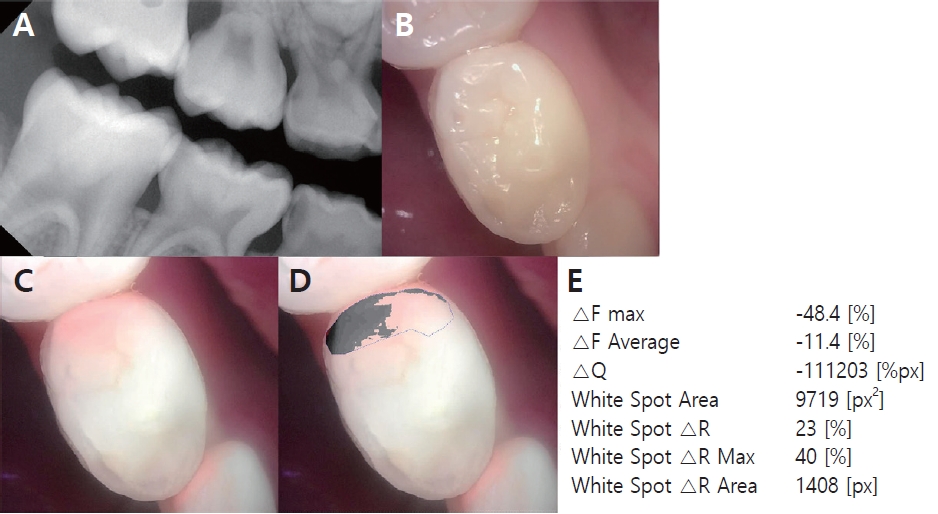1. Gomez J, Zakian C, Pretty IA,
et al. : In vitro performance of different methods in detecting occlusal caries lesions.
J Dent, 41:180-186, 2013.


2. Arnold W, Gaengler P, Kalkutschke L : Three-dimensional reconstruction of approximal subsurface caries lesions in deciduous molars.
Clin Oral Investig, 2:174-179, 1998.


3. Mortimer K : The relationship of deciduous enamel structure to dental disease.
Caries Res, 4:206-223, 1970.


4. Wilson P, Beynon A : Mineralization differences between human deciduous and permanent enamel measured by quantitative microradiography.
Arch Oral Biol, 34:85-88, 1989.


5. Rayner J, Southarn J : Pulp changes in deciduous teeth associated with deep carious dentine.
J Dent, 7:39-42, 1979.


6. Tickotsky N, Petel R, Araki R, Moskovitz M : Caries Progression Rate in Primary Teeth: A Retrospective Study.
J Clin Pediatr Dent, 41:358-361, 2017.


7. Gimenez T, Piovesan C, Ricketts DN,
et al. : Visual Inspection for Caries Detection: A Systematic Review and Metaanalysis.
J Dent Res, 94:895-904, 2015.



8. Newman B, Seow WK, Holcombe T,
et al. : Clinical detection of caries in the primary dentition with and without bitewing radiography.
Aust Dent J, 54:23-30, 2009.


9. Affairs ADACoS : The use of dental radiographs: update and recommendations.
J Am Dent Assoc, 137:1304-1312, 2006.

10. Josselin de Jong E, Higham SM, van der Veen MH, et al. : Quantified light-induced fluorescence, review of a diagnostic tool in prevention of oral disease. J Appl Phys, 105, 2009.
11. Park SW, Kim SK, Kim BI,
et al. : Comparison of fluorescence parameters between three generations of QLF devices for detecting enamel caries
in vitro and on smooth surfaces.
Photodiagnosis Photodyn Ther, 25:142-147, 2019.


12. Kim ES, Lee ES, Kim BI,
et al. : A new screening method to detect proximal dental caries using fluorescence imaging.
Photodiagnosis Photodyn Ther, 20:257-262, 2017.


13. Gomez J, Tellez M, Ismail AI,
et al. : Non-cavitated carious lesions detection methods: a systematic review.
Community Dent Oral Epidemiol, 41:54-66, 2013.


14. Ando M, van der Veen MH, Schemehorn BR, Stookey GK : Comparative study to quantify demineralized enamel in deciduous and permanent teeth using laser-and light-induced fluorescence techniques.
Caries Res, 35:464-470, 2001.


15. Bader JD, Shugars DA, Bonito AJ : A systematic review of the performance of methods for identifying carious lesions.
J Public Health Dent, 62:201-213, 2002.


16. Novaes TF, Matos R, Mendes FM,
et al. : Influence of the discomfort reported by children on the performance of approximal caries detection methods.
Caries Res, 44:465-471, 2010.


17. Jung EH, Lee ES, Kim BI,
et al. : Development of a fluorescence-image scoring system for assessing noncavitated occlusal caries.
Photodiagnosis Photodyn Ther, 21:36-42, 2018.


18. Gomez GF, Eckert GJ, Zandona AF : Orange/red fluorescence of active caries by retrospective quantitative light-induced fluorescence image analysis.
Caries Res, 50:295-302, 2016.


19. Kim HE, Kim BI : Analysis of orange/red fluorescence for bacterial activity in initial carious lesions may provide accurate lesion activity assessment for caries progression.
J Evid Based Dent Pract, 17:125-128, 2017.


20. Tan P, Evans R, Morgan M : Caries, bitewings, and treatment decisions.
Aust Den J, 47:138-141, 2002.

21. Bussaneli DG, Restrepo M, Cordeiro RC,
et al. : Proximal caries lesion detection in primary teeth: does this justify the association of diagnostic methods.
Lasers Med Sci, 30:2239-2244, 2015.


22. Wenzel A : Radiographic display of carious lesions and cavitation in approximal surfaces: advantages and drawbacks of conventional and advanced modalities.
Acta Odontol Scand, 72:251-264, 2014.


23. Souza LA, Cancio V, Tostes MA : Accuracy of pen-type laser fluorescence device and radiographic methods in detecting approximal carious lesions in primary teeth - an
in vivo study.
Int J Paediatr Dent, 28:472-480, 2018.

24. Chen J, Qin M, Ma W, Ge L : A clinical study of a laser fluorescence device for the detection of approximal caries in primary molars.
Int J Paediatr Dent, 22:132-138, 2012.


25. Buchalla W, Lennon A, Van Der Veen M, Stookey G : Optimal camera and illumination angulations for detection of interproximal caries using quantitative light-induced fluorescence.
Caries Res, 36:320-326, 2002.


26. Ko HY, Kang SM, Kim BI,
et al. : Validation of quantitative light-induced fluorescence-digital (QLF-D) for the detection of approximal caries
in vitro.
J Dent, 43:568-575, 2015.


27. Ando M, Schemehorn BR, Stookey GK,
et al. : Influence of enamel thickness on quantification of mineral loss in enamel using laser-induced fluorescence.
Caries Res, 37:24-28, 2003.

















 PDF Links
PDF Links PubReader
PubReader Full text via DOI
Full text via DOI Download Citation
Download Citation Print
Print



